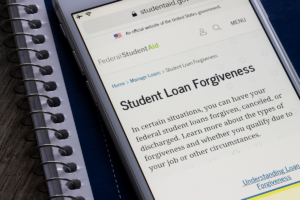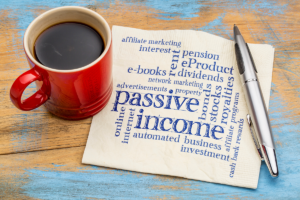How to Prepare Your Finances for Student Loan Payments

What to Do if You Can’t Afford Your Car Payment
02/09/2024
How to Break Free From Debt and Get Ahead With Your Tax Refund: Pay Bills, Settle Debt, & Grow Savings
02/25/2024Back in 2020, the federal government gave student loan borrowers a payment reprieve. The temporary measure was designed to help borrowers with federal student loans get through the financial uncertainty caused by the pandemic.
But the federal student loan payment pause came to an end in fall 2023. If you are a federal student loan borrower, the restart of payments may have a big impact on your financial situation. Let’s explore how you can prepare your finances for student loan payments.
When Did Student Loan Payments Restart?
During the federal student loan payment pause, the interest rate was set to 0%. With that, your student loan balance wasn’t growing during the payment pause, even if you chose not to make any payments toward the principal balance.
After many delays, federal student loan payments resumed in October, with interest accruing starting September 1, 2023.
Of course, this payment pause only applied to federal student loans. If you carry private student loans, you were likely required to continue making payments toward your balance the entire time.
How to Stay on Top of Student Loan Payments
For borrowers with federal student loan debt, the payment burden can be heavy. On average, student borrowers take on over $30,000 in debt to pursue a bachelor’s degree.
Based on the latest data, the average federal student loan debt is $37,338 per borrower. And student loan debt tends to stick around, with over half of the student borrowers owing more than $20,000 in outstanding loan balances 20 years after entering school.
With balances like these, it’s easy to see how student loan payments could upend your financial plans—but preparing to make this monthly payment can make a big difference.
Below are some strategies to help you keep making your student loan payments on time.
Know Your Loan Servicer
When you pay your federal student loans, you don’t make these payments directly to the federal government. Instead, the U.S. Department of Education works with several contractors who act as loan servicers.
As a borrower, you don’t get to choose who your loan servicer is. But need to know which loan servicer is handling your student loans.
If you’re not sure who your student loan servicer is, you can look it up through the Department of Education. Start by logging into your federal student loan dashboard, then scroll to the “My Loan Servicers” section. From there, you should be able to tell who your student loan servicer is.
Once you find out who your loan servicer is, you can confirm your payment due dates, the amount of your monthly payments, and what payment methods are accepted.
Find Out How Much You Owe
When it comes to paying off debt, it’s critical to understand how much you owe. If you have federal student loans, now is a good time to nail down your exact loan balance.
You can find this information by logging into your account at StudentAid.gov. Within this platform, you can determine your total loan balance and minimum monthly payment. Both are key pieces of information to have as you move forward with your student loan repayment journey.
Update Your Contact Information
For many college graduates, the period after graduation comes with many transitions. If you find yourself moving apartments or changing your email address, don’t forget to let your student loan servicer know. Otherwise, you might miss out on important communications from the loan servicer.
Missed information might not seem like a big deal. But if you miss information about your student loan repayment situation, it could cause you to miss a payment. Missed payments can have a negative impact on your credit score in the long term. With that, staying in communication with your lender is a top priority.
Consider Your Repayment Options
Federal student loans have several different repayment methods available. As the borrower, it’s helpful to learn more about your options to find the right fit for your situation.
Here’s a closer look at your student loan repayment options:
- Standard repayment: When you graduate from school, you’ll be put on the standard student loan repayment plan. The standard repayment plan comes with a 10-year loan term. But the monthly payment might not suit your budget.
- Revised Pay As You Earn Plan (REPAYE): In general, this plan requires you to pay 10% of your discretionary income toward student loan repayment. The term is 20 years for undergraduate loans and 25 years for graduate loans.
- Pay As You Earn Repayment Plan (PAYE): PAYE generally requires you to pay 10% of your discretionary income toward student loan repayment, but never more than the standard repayment amount. The payments continue for 20 years.
- Income-Based Repayment Plan (IBR): The IBR plan usually involves paying 10% of your discretionary income toward your loans, but never more than the standard repayment amount. The loan term is either 20 or 25 years.
- Income-Contingent Repayment Plan (ICR): The ICR plan generally involves paying 20% of your discretionary income or what you would pay on a 12-year repayment plan. The loan term is 25 years.
The income-based repayment plans can make a big difference in your monthly budget. At the end of the loan term, the federal government will forgive the remaining loan amount. Although you’ll be stuck making payments for potentially decades, the IBR plans offer a light at the end of the tunnel if you are dealing with an unaffordable student loan balance.
Explore Student Loan Forgiveness Options
Some borrowers may qualify for loan forgiveness programs. It’s worth doing some research to see if you qualify because loan forgiveness can make a significant difference in your financial future. Here’s a look at some of the most popular student loan forgiveness options:
- IBR plans: Remember, IBR plans have a built-in loan forgiveness opportunity. If you sign up for an IBR plan and make your payments for decades, the remaining loan balance can be forgiven at the end of the loan term.
- Public Service Loan Forgiveness (PSLF): If you work at an eligible non-profit or government agency full-time for at least 10 years while making 120 qualifying payments, you can apply for loan forgiveness. Notably, these forgiven loans don’t count as taxable income.
- Teacher Loan Forgiveness: Teachers can qualify for up to $17,500 in loan forgiveness after teaching full-time for five consecutive academic years in a low-income elementary or secondary school.
If you think you might qualify for a forgiveness option, do your homework. Student loan forgiveness can transform your financial future. But in general, there are lots of rules around the process. With that, you’ll need to read the fine print of any loan forgiveness opportunities you want to pursue. Make sure to check all of the boxes to avoid an unwelcome surprise.
Sign Up for the Ideal Repayment Option
Take a close look at all of your repayment options. When you’ve landed on the right fit for your situation, it’s time to file the paperwork. That’s right—as with almost everything related to your student loans, you’ll need to file a special form to sign up for an adjusted repayment option.
If you have questions about signing up for a different repayment schedule, reach out to your loan servicer. In many cases, the loan servicer can guide you through the process to avoid any unnecessary hiccups.
Make a Realistic Monthly Budget
After signing up for the repayment program of your choice, you should have a better understanding of your monthly payment. With that information, it’s time to make a realistic monthly budget that takes your student loan payment into account.
Below are some tips to help you build a realistic monthly budget:
- Look for savings on your biggest expenses: Cutting back on your morning coffee might have an impact on your budget. But you’ll likely find more worthwhile savings by evaluating your biggest expenses. For most households, the biggest expenses include housing, food, and transportation. If possible, cut back on those big expenses. For example, you might downsize your apartment or trade in your vehicle for a more affordable ride.
- Get clear on your goals: Creating a budget without setting financial goals is like going for a drive without a destination. Take some time to get clear on where you want to go with your finances. For example, you might want to pay off your student loans ASAP, save for a down payment on a house, take a dream vacation, or build a solid emergency fund. When you have a financial goal in mind, you can adjust the budget to meet that goal. For example, if you want to save for a $1,200 vacation in 12 months, you can plan on setting aside $100 per month to hit that goal.
- Leave room for fun: Building a budget without leaving any room for fun is a dangerous game. Without any wiggle room for what makes you happy, it’s easy to get burned out on making progress toward your financial goals. Make room in the budget for indulgences that make you smile, even if it’s just $10 a month.
As you build out your budget, strike a balance that works best for your situation.
Sign Up for Automatic Payments
When you start making student loan payments, consider signing up for autopay. According to the Consumer Finance Protection Bureau, all federal loans offer an autopay discount. You can get 0.25% knocked off your interest rate by committing to automatic payments.
Saving money isn’t the only perk offered by signing up for autopay. You’ll also have the peace of mind that comes with taking this chore off of your to-do list.
The reality is that it’s easy to miss a payment due date. Life can get in the way of you making on-time payments. If you are prone to forgetting to make an on-time payment, automatic payments are especially useful.
Find New Earning Opportunities
Paying back your student loans isn’t always easy. That’s especially true if the minimum payment is putting a crunch on your budget or you want to pay off your loans ahead of schedule.
The good news is that you can tap into new earning opportunities to cover your payments more comfortably.
Below are some strategies to help you earn more:
- Negotiate for a raise: When you want to earn more money, your day job is a good place to start your search. If you want to get a raise, come prepared with information that backs up your ask. For example, you might point out the extra work you’ve been doing or the average salary for your job in the area.
 Find a job with a higher salary: If asking for a raise doesn’t work out, it might be time to start job hunting. Of course, compensation isn’t the only factor when choosing a job. But if you aren’t satisfied with your salary at your current job, moving to a new job might be the best option.
Find a job with a higher salary: If asking for a raise doesn’t work out, it might be time to start job hunting. Of course, compensation isn’t the only factor when choosing a job. But if you aren’t satisfied with your salary at your current job, moving to a new job might be the best option.- Pick up extra hours: Some workplaces offer overtime pay for picking up extra hours. If you have that option, it might be a good solution for earning more.
- Start a side hustle: Side hustles offer a way to earn money outside of your day job. The right side hustle can transform your finances. A few ideas to get you started include pet sitting, freelance creative work, and selling crafts on Etsy.
- Sell things from around the house: If you have extra clutter taking up space around your house, consider selling it. Not only can you put these funds toward your debt, but you can also free up some space in your home.
When it comes to earning extra money, don’t be afraid to get creative.
Frequently Asked Questions
You have questions about student loan payments. We have answers.
What Is the Average Student Loan Debt?
The average amount of federal student loan debt is $37,338 per borrower.
How to Pay Off 100k in Student Loans Fast?
If you have a large student loan balance you want to eliminate quickly, you’ll need to find ways to make more than the minimum payment every month. You might choose to cut back on discretionary purchases, live with roommates, or pick up a second job to funnel extra funds toward your student loan balance every month.
The Bottom Line
While student loans offer an opportunity to obtain a college degree, the weight of this debt can feel like a burden after graduation. Now that student loan payments have resumed, it’s helpful to be proactive with your approach. With careful organization and a bit of creativity, you can make the best of your financial situation even if you have student loan payments.






